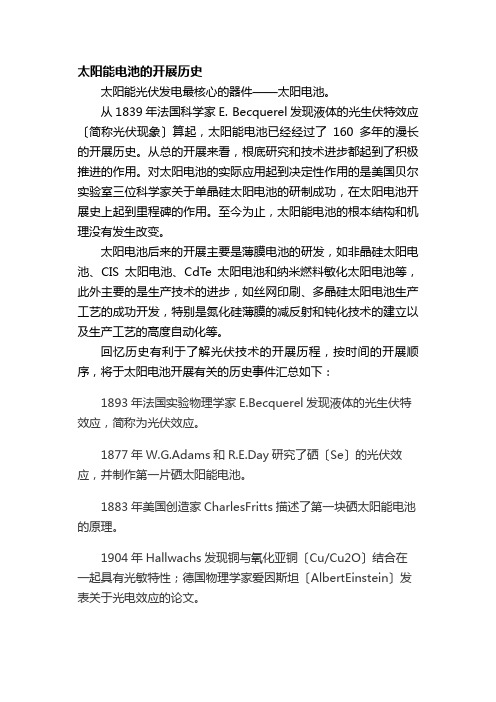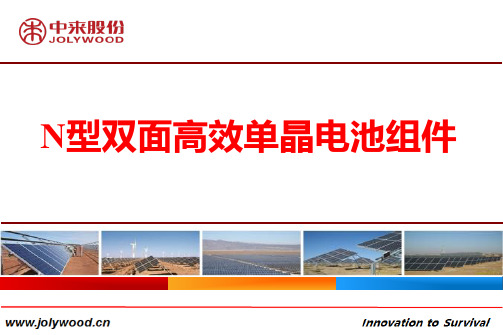2015-08-10德国Fraunhofer ISE光伏报告
太阳能电池发展历史独家收集整理

太阳能电池的开展历史太阳能光伏发电最核心的器件——太阳电池。
从1839年法国科学家E. Becquerel发现液体的光生伏特效应〔简称光伏现象〕算起,太阳能电池已经经过了160多年的漫长的开展历史。
从总的开展来看,根底研究和技术进步都起到了积极推进的作用。
对太阳电池的实际应用起到决定性作用的是美国贝尔实验室三位科学家关于单晶硅太阳电池的研制成功,在太阳电池开展史上起到里程碑的作用。
至今为止,太阳能电池的根本结构和机理没有发生改变。
太阳电池后来的开展主要是薄膜电池的研发,如非晶硅太阳电池、CIS太阳电池、CdTe太阳电池和纳米燃料敏化太阳电池等,此外主要的是生产技术的进步,如丝网印刷、多晶硅太阳电池生产工艺的成功开发,特别是氮化硅薄膜的减反射和钝化技术的建立以及生产工艺的高度自动化等。
回忆历史有利于了解光伏技术的开展历程,按时间的开展顺序,将于太阳电池开展有关的历史事件汇总如下:1893年法国实验物理学家E.Becquerel发现液体的光生伏特效应,简称为光伏效应。
1877年W.G.Adams和R.E.Day研究了硒〔Se〕的光伏效应,并制作第一片硒太阳能电池。
1883年美国创造家CharlesFritts描述了第一块硒太阳能电池的原理。
1904年Hallwachs发现铜与氧化亚铜〔Cu/Cu2O〕结合在一起具有光敏特性;德国物理学家爱因斯坦〔AlbertEinstein〕发表关于光电效应的论文。
1918年波兰科学家Czochralski开展生长单晶硅的提拉法工艺。
1921年德国物理学家爱因斯坦由于1904年提出的解释光电效应的理论获得诺贝尔〔Nobel〕物理奖。
1930年ng研究氧化亚铜/铜太阳能电池,发表“新型光伏电池〞论文;W.Schottky发表“新型氧化亚铜光电池〞论文。
1932年Audobert和Stora发现硫化镉(CdS)的光伏现象。
1933年L.O.Grondahl发表“铜-氧化亚铜整流器和光电池〞论文.1951年生长p-n结,实现制备单晶锗电池。
光伏组件质量问题总结分析

光伏组件质量问题总结分析网状隐裂原因1.电池片在焊接或搬运过程中受外力造成.2.电池片在低温下没有经过预热在短时间内突然受到高温后出现膨胀造成隐裂现象组件影响:1.网状隐裂会影响组件功率衰减.2.网状隐裂长时间出现碎片,出现热斑等直接影响组件性能预防措施:1.在生产过程中避免电池片过于受到外力碰撞.2.在焊接过程中电池片要提前保温(手焊)烙铁温度要符合要求.3.EL测试要严格要求检验.网状隐裂EVA脱层原因1.交联度不合格.(如层压机温度低,层压时间短等)造成2.EVA、玻璃、背板等原材料表面有异物造成.3.EVA原材料成分(例如乙烯和醋酸乙烯)不均导致不能在正常温度下溶解造成脱层4.助焊剂用量过多,在外界长时间遇到高温出现延主栅线脱层组件影响:1.脱层面积较小时影响组件大功率失效。
当脱层面积较大时直接导致组件失效报废预防措施:1.严格控制层压机温度、时间等重要参数并定期按照要求做交联度实验,并将交联度控制在85%±5%内。
2.加强原材料供应商的改善及原材检验.3.加强制程过程中成品外观检验4.严格控制助焊剂用量,尽量不超过主栅线两侧0.3mm硅胶不良导致分层&电池片交叉隐裂纹原因1.交联度不合格.(如层压机温度低,层压时间短等)造成2.EVA、玻璃、背板等原材料表面有异物造成.3.边框打胶有缝隙,雨水进入缝隙内后组件长时间工作中发热导致组件边缘脱层4.电池片或组件受外力造成隐裂组件影响:1.分层会导致组件内部进水使组件内部短路造成组件报废2.交叉隐裂会造成纹碎片使电池失效,组件功率衰减直接影响组件性能预防措施:1.严格控制层压机温度、时间等重要参数并定期按照要求做交联度实验。
2.加强原材料供应商的改善及原材检验.3.加强制程过程中成品外观检验4.总装打胶严格要求操作手法,硅胶需要完全密封5.抬放组件时避免受外力碰撞硅胶不电池交良分层叉隐裂纹组件烧坏原因1.汇流条与焊带接触面积较小或虚焊出现电阻加大发热造成组件烧毁组件影响:1.短时间内对组件无影响,组件在外界发电系统上长时间工作会被烧坏最终导致报废预防措施:1.在汇流条焊接和组件修复工序需要严格按照作业指导书要求进行焊接,避免在焊接过程中出现焊接面积过小.2.焊接完成后需要目视一下是否焊接ok.3.严格控制焊接烙铁问题在管控范围内(375±15)和焊接时间2-3s 组件内部烧坏组件接线盒起火原因1.引线在卡槽内没有被卡紧出现打火起火.2.引线和接线盒焊点焊接面积过小出现电阻过大造成着火.3.引线过长接触接线盒塑胶件长时间受热会造成起火组件影响:1.起火直接造成组件报废,严重可能一起火灾.预防措施:1.严格按照sop作业将引出线完全插入卡槽内2.引出线和接线盒焊点焊接面积至少大于20平方毫米.3.严格控制引出线长度符合图纸要求,按照sop作业.避免引出线接触接线盒塑胶件.电池片隐裂原因1.焊接过程中操作不当造成裂片2.人员抬放时手法不正确造成组件裂片3.层压机故障出现组件类片组件影响:1.裂片部分失效影响组件功率衰减,2.单片电池片功率衰减或完全失效影响组件功率衰减预防措施:1.汇流条焊接和返工区域严格按照sop手法进行操作2.人员抬放组件时严格按照工艺要求手法进行抬放组件.3.确保层压机定期的保养.每做过设备的配件更换都要严格做好首件确认ok后在生产.4.EL测试严格把关检验,禁止不良漏失.电池助焊剂用量过多原因1.焊接机调整助焊剂喷射量过大造成2.人员在返修时涂抹助焊剂过多导致组件影响:1.影响组件主栅线位置EVA脱层,2.组件在发电系统上长时间后出现闪电纹黑斑,影响组件功率衰减使组件寿命减少或造成报废预防措施:1.调整焊接机助焊剂喷射量.定时检查.2.返修区域在更换电池片时请使用指定的助焊笔,禁止用大头毛刷涂抹助焊剂虚焊、过焊原因1.焊接温度过多或助焊剂涂抹过少或速度过快会导致虚焊2.焊接温度过高或焊接时间过长会导致过焊现象.组件影响:1.虚焊在短时间出现焊带与电池片脱层,影响组件功率衰减或失效,2.过焊导致电池片内部电极被损坏,直接影响组件功率衰减降低组件寿命或造成报废预防措施:1.确保焊接机温度、助焊剂喷射量和焊接时间的参数设定.并要定期检查,2.返修区域要确保烙铁的温度、焊接时间和使用正确的助焊笔涂抹助焊剂.3.加强EL检验力度,避免不良漏失下一工序.焊带偏移或焊接后翘曲破片原因1.焊接机定位出现异常会造成焊带偏移现象2.电池片原材主栅线偏移会造成焊接后焊带与主栅线偏移3.温度过高焊带弯曲硬度过大导致焊接完后电池片弯曲组件影响:1.偏移会导致焊带与电池面积接触减少,出现脱层或影响功率衰减2.过焊导致电池片内部电极被损坏,直接影响组件功率衰减降低组件寿命或造成报废3.焊接后弯曲造成电池片碎片预防措施:1.定期检查焊接机的定位系统.2.加强电池片和焊带原材料的来料检验,组件钢化玻璃爆和接线盒导线断裂原因1.组件在搬运过程中受到严重外力碰撞造成玻璃爆破2.玻璃原材有杂质出现原材自爆.3.导线没有按照规定位置放置导致导线背压坏.组件影响:1.玻璃爆破组件直接报废,2.导线损坏导致组件功率失效或出现漏电连电危险事故预防措施:1.组件在抬放过程中要轻拿轻放.避免受外力碰撞.2.加强玻璃原材检验测试,3.导线一定要严格按照要求盘放.避免零散在组件上气泡产生原因1.层压机抽真空温度时间过短,温度设定过低或过高会出现气泡2.内部不干净有异物会出现气泡.3.上手绝缘小条尺寸过大或过小会导致气泡.组件影响:1.组件气泡会影响脱层.严重会导致报废预防措施:1.层压机抽真空时间温度参数设定要严格按照工艺要求设定.2.焊接和层叠工序要注意工序5s清洁,3.绝缘小条裁切尺寸严格要求进行裁切和检查.热斑和脱层原因1.组件修复时有异物在表面会造成热斑2.焊接附着力不够会造成热斑点.3.脱层层压温度、时间等参数不符合标准造成组件影响:1.热斑导致组件功率衰减失效或者直接导致组件烧毁报废.2.脱层导致组件功率衰减或失效影响组件寿命使组件报废.预防措施:1.严格按照返修SOP要求操作,并注意返修后检查注意5s.2.焊接处烙铁温度焊焊机时间的控制要符合标准,3.定时检查层压机参数是否符合工艺要求.同时要按时做交联度实验确保交联度符合要求85%±5%.电池热脱层斑烧毁EVA脱层原因1.交联度不合格.(如层压机温度低,层压时间短等)造成2.EVA、玻璃、背板等原材料表面有异物造成.3.EVA原材料成分(例如乙烯和醋酸乙烯)不均导致不能在正常温度下溶解造成脱层组件影响:1.脱层会导致组件内部进水使组件内部短路造成组件失效至报废预防措施:1.严格控制层压机温度、时间等重要参数并定期按照要求做交联度实验。
双面电池光伏组件-FraunhoferISE

技术中心(Module-TEC),我们会利用 不同规格的组件样品(由1-60片电池构 成)测试创新的电池片接线和封装技术。
对于这类造成衰减的因素,非破坏性监测 有助于我们的客户在早期阶段识别潜在的 衰减方式。 客户服务 我们的测量服务可以配合客户的需求组合
1200 1000 Irradiance (W/m2) 800 600 400 200 0 0 10 20 30 40 50 60 70 80 90 total measured front measured rear measured total modelled front modelled rear modelled
TestLab中,我们可执行客制化的加速试 验,并对产品进行预认证以及认证测试。
透过在各地不同气候条件下的室外测试 站,我们可以分析双面电池组件在实际天 气条件下的衰减行为。其中不同材料组合 对于组件长期可靠性的影响将是分析重点 之一。
与产能相关的重要参数,如低光性能、温 度系数和背面的组件效率等,是量测双面 电池组件特性时的重要依据。根据客户的 特殊需求,我们可以对指定的特性进行测 量。配合新的测试装置,我们提供的测 量服务将优于新标准IECNP 60904-1-2TS。
为了保证标定双面电池组件时,仍能保持 良好的测量精度与重复性,我们使用非反 光(“全黑”)背景分别对正反两面进行 测量。此外,藉由弗劳恩霍夫太阳能研究 所 ISE开发的新型测试装置,我们能够在 不同光照强度下同时测量正面和背面。
过模拟验证。
效率分析与优化 为了极大化双面技术带来的效益,组件设 计和材料需要适当地配合。我们针对组件 效率和性能的电气及光学模拟将提供材料 和组件制造商完善的支持。在所内的组件
Fraunhofer Institute for Solar Energy Systems ISE Heidenhofstr. 2 79110 Freiburg, Germany
(完整word版)背钝化简介

晶硅太阳能电池的表面钝化一直是设计和优化的重中之重.从早期的仅有背电场钝化,到正面氮化硅钝化,再到背面引入诸如氧化硅、氧化铝、氮化硅等介质层的钝化局部开孔接触的PERC/PERL设计。
虽然这一结构暂时缓解了背面钝化的问题,但并未根除,开孔处的高复合速率依然存在,而且使工艺进一步复杂.表面钝化的演进钝化的“史前时代"SiNx:H 第一次进化90年代,科研机构和制造商开始探索使用等离子体增强化学气相沉积(PECVD)技术制备含氢的氮化硅(SiNx:H)薄膜用作电池正面的减反射膜。
其中原因之一在于相对合适的折射率,但更重要的原因则在于氮化硅优良的的钝化效果。
氮化硅除了可以饱和表面悬挂键,降低界面态外,还通过自身的正电荷,减少正面n型硅中的少子浓度,从而降低表面复合速率。
SiNx中携带的氢可以在烧结的过程中扩散到硅片中,对发射极和硅片的内部晶体缺陷进行钝化,这对品质较低的多晶硅片尤其有效,大幅提高了当时太阳能电池的效率。
伴随着钝化材料上的创新,银浆材料与烧结工艺上的变革也同时到来,那就是可以烧穿的浆料和共烧(Co—firing)烧结工艺.有了烧穿特性后,可以先进行减反射膜的沉积,后网印浆料,然后烧结.由于顺序的颠倒,不用再担心金属栅线上覆盖的减反射层影响焊接,也省去了沉积TiO2需要的部分遮挡。
同时人们发明了将正反面浆料一次烧结的共烧工艺,在一次烧结中,正面的银浆穿过SiNx与硅形成接触,而背面的铝浆也同步形成背面电极和背电场(back surface field).这一系列改进大大简化了丝网印刷电池的工艺,并逐渐成为了晶硅电池生产的主流。
AlOx 第二次进化随着电池正面的钝化效果和接触性能由于SiNx的使用和银浆改进在不断提高,进一步优化正面已经进入瓶颈阶段,人们把视线投向了另一个复合严重的区域,那就是电池的背表面.虽然在传统丝网印刷的晶硅电池中,铝背场可以减少少子浓度,减少复合,但仍然无法与使用介质层带来的钝化效果相比较。
p_型TOPCon_技术及其在高效晶体硅太阳电池应用的研究进展

太 阳 能第12期 总第356期2023年12月No.12 Total No.356 Dec., 2023SOLAR ENERGY0 引言2022年1月,习近平总书记指出,要把促进新能源和清洁能源发展放在更加突出的位置,积极有序发展光能源、硅能源、氢能源、可再生能源。
基于晶体硅太阳电池等应用方向的硅能源(即光伏发电技术)将成为支撑碳中和战略目标的主要清洁能源之一。
过去10多年,晶体硅太阳电池的量产光电转换效率以每年0.5%~0.6%的速度提升;而从2006年至今,光伏组件则以累计出货量每翻1倍其价格就减少39.5%的速度下降[1]。
国际光伏技术路线图(ITRPV)(第13版)[1]指出:硅太阳电池仍是未来10年光伏发电的主导技术。
根据国家发展和改革委员会的预计,2050年光伏发电量将占中国总用电量的40%[2]。
因此,提升晶体硅太阳电池的光电转换效率、降低其生产成本对增强光伏发电的竞争力,促进中国能源结构转型具有重大意义。
据德国弗劳恩霍夫太阳能研究所(Fraunhofer-ISE)的预测,钝化接触技术具有将太阳电池量产光电转换效率提升至25%~26%的潜力,代表量产晶体硅太阳电池的发展方向。
隧穿氧化硅钝化接触(TOPCon)技术是一种典型的钝化接触技术,其特征是采用超薄氧化硅和重掺杂多晶硅,同时实现优异的表面钝化和载流子选择性收集,避免金属与硅的复合损失[3]。
德国哈梅林太阳能研究所(ISFH)的研究表明:如果采用结合钝化与接触两个关键性能的选择性因子S10来评判晶体硅太阳电池技术的优劣[4],TOPCon太阳电池技术在各项技术中具有最佳的选择性因子,拥有最高理论光电转换效率,是一种可迭代升级、具有长生命周期的技术[5]。
德国ISFH开发出了实验室光电转换效率达到26.1%的概念验证型pDOI: 10.19911/j.1003-0417.tyn20220920.02 文章编号:1003-0417(2023)12-36-11p型TOPCon技术及其在高效晶体硅太阳电池应用的研究进展曾俞衡*,林 娜,刘 伟,闫宝杰,夏庆锋,叶继春(中国科学院宁波材料技术与工程研究所,宁波 315201)摘 要:隧穿氧化硅钝化接触(TOPCon)晶体硅太阳电池被广泛认可为下一代高效太阳电池技术,n型TOPCon技术已成为当前新上生产线的主流方案。
N型双面高效单晶电池和组件-1

N型双面高效单晶电池组件1公司介绍2N型双面电池片3 N型双面电池组件优势CONTENTS4 电站投资成本及收益5 N型双面电池组件产品6 技术路线苏州中来光伏新材股份有限公司(简称中来股份)成立于2008年3月,是国内第一家专业从事太阳能电池背膜研发、生产和销售的上市企业(股票代码:300393),业内最先实现涂覆型太阳电池背膜产业化生产的企业之一,目前为全球最大的专业背膜制造企业。
公司同时致力于高效太阳能电池的设计和研发,已申请高效电池相关专利26项,其中已授权12项,单晶双面发电高效太阳能电池的技术开发能力处于国内领先、国际先进水平。
中来电力主要从事光伏电站投资、融资、建设及运维服务,侧重投资农光互补电站及工商业屋顶分布式电站。
●公司性质:股份有限公司●公司地址:常熟市沙家浜镇常昆工业园区●成立时间:2008.03.07 ●生产能力:年配套光伏组件能力10GW●业务范围:背膜技术+高效电池+电站投融资及运维泰州中来光电科技有限公司项目计划投资建设14条N型单晶双面太阳能电池生产线,包括单晶制绒设备、扩散设备、刻蚀设备等。
项目总投资165,832.00万元,建设期1.5年,达产后将实现2.1GW产能,可完善公司产品结构,满足市场需求。
在晶硅太阳能电池技术路线中,低成本、高转换效率一直是太阳能电池技术发展的重点。
N型单晶太阳能电池基于自身结构特性,具有光电转换效率高、光衰减系数低、弱光响应等优势,本项目生产的N型单晶双面太阳能电池通过采用离子注入等技术,精简了产品工艺流程,提高产品良品率,产品生产成本得以降低。
本项目生产的N型单晶电池为双面电池,与单面电池相比,采用该款N型单晶双面电池可使得同等投资的光伏电站发电量有较大幅度提高,亦可在同等发电规模下减少土地占用。
N 型单晶双面电池核心技术N 型硅片,正面硼扩散形成P+层,背面磷扩散形成N+层,双面沉积氮化硅减反膜,最后印刷银电极。
01020304硼扩散工艺新工艺开发、掺杂的浓度,结深等对p-n 结特性的影响离子注入法磷扩散简化工艺,提升效率表面钝化工艺降低表面缺陷减少载流子复合新一代双二次印刷工艺提升效率,保证品质N 型双面电池N 型单晶双面电池转换效率Eta(%)Voc (V)Jsc(A )FF 21.0%0.6549.9078.70正面平均效率>21.0%高效双面发电背面平均效率>19.0%N 型单晶/P 型多晶光衰数据对比1.281.581.221.671.441.691.761.83-0.13-0.15-0.140.120.09-0.10.150.08-0.500.511.522.5020406080100120功率衰减(%)辐照量(KWh )P 型多晶N 型单晶光致衰减低弱光响应强由于N型基体材料高的少子寿命,N型晶硅组件在弱光下表现出比常规P型晶硅组件更优异的发电特性。
深度解读德国光伏产业:2018或是未来十年的新起点

Architectural&Functional Glass No12019好,现有情况下增加5%〜10%的发电量都有可能。
”深度解读德国光伏产业:2018或是未来十年的新起点让我们记住2018年的原因,是2018年可能是未来十年德国光伏的新起点。
2014年~2018年装机量在节节爬升的趋势下,2019年光伏又将如何发展?2018年对德国光伏有着重要的意义。
这一年,是德国自2014年以来五年中首年光伏装机超过2GW的节点。
这一年,可再生能源发电量占比超过40%,德国可再生能源事业取得了亮眼的成绩。
最重要的是,让我们记住2018年的原因,是2018年可能是未来十年德国光伏的新起点。
2014年~2018年装机量在节节爬升的趋势下,2019年光伏又将如何发展?西方战车觉醒首次达到2.5GW目标德国光伏也曾经历过大跃进的年代,2009年新增装机4.5吉瓦,2010年~2012年连续三年新增装机超过7吉瓦,是德国光伏发展的高光时刻。
此后,由于光伏补贴政策的调整,2013年作为缓冲,2014年光伏装机量显现出断崖式下跌。
随后德国政府为新增光伏设立了2.5吉瓦的目标,但是2014年~2017年连续四年新增装机均低于2吉瓦。
2018年,这一低迷状态终于好转。
数据显示,2018年1至10月德国光伏装机已经达到2.4吉瓦,全年达到2.5吉瓦已无悬念。
Fraunhofer ISE对2018年的光伏装机情况更为乐观,根据近日Fraunhofer ISE发布的调研报告显示,预计全年光伏装机量增加约3.2吉瓦。
400 350 300 250 200 150 100 50 03425351I270.74ill223198182.Hl4月5月6月7月8月9月10月11月■德国2018光伏装机情况(按月)新增装机塑(MW)德国2018年光伏装机情况(MW)目前德国联邦网络局尚未公布最终并网数据。
德国可再生能源发电占比已超过40%德国研究机构Fraunhofer ISE今年1月发布了德国能源结构调查,调研报告显示,德国2018年可再生能源发电总量达到219TWh,净发电量中可再生能源的比例首次超过40%,相比2017年增长4.3%O光伏系统全年发电量45.7TWh,发电量占全部电力消费量的&5%,同比增长16%,表现抢眼。
TOPCon电池专题研究

TOPCon电池专题研究TOPCon工序:与Perc兼容设备成本低,新结构打开增效空间提高光电转换效率是永恒命题,TOPCOn是现阶段P型转N型主力军TOPCon为N型电池的技术路线之一,凭借明显的优势有望替代P 型电池成为新一代电池技术。
目前光伏行业主流为P型电池(PERC技术为主),其制造工艺简单、成本更低。
相比传统的P型电池,N型电池具有转换效率高、双面率高、温度系数低、几乎无光衰、弱光效应好等优点,但制造工艺复杂、成本更高,被行业普遍认为是下一代的电池技术。
TOPCon电池技术为N型电池主流技术路线之一。
N型半导体多数载流子是电子,电子有效质量更低,迁移速率高。
在相同导电能力情况下,N型杂质少,因此少数载流子寿命更高,能够直接影响开路电压和短路电流,因此拥有更高的光电转换效率。
钝化接触结构降低复合损耗,打开增效空间TOPCon是一种基于选择性载流子原理的隧穿氧化层钝化接触(TunnelOxidePassivatedContact)太阳能电池技术,是N型硅衬底电池。
TOPCon电池的概念由德国弗劳恩霍夫太阳能系统研究所(Fraunhofer-ISE)于2013年提出。
在TOPCon电池的背面制备一层1~2nm的超薄氧化硅(隧穿氧化层),然后再沉积一层20nm左右的掺杂多晶硅薄层,二者共同形成了钝化接触结构作为电池背面钝化层,有效降低表面复合和界面复合,提高开压,为电池的转换效率进一步提升提供了更大的空间。
具有与Perc产线的兼容性,助力TOPCon引领P转N型在P型电池的工艺基础上,TOPCon电池将磷扩散改为硼扩散,增加了隧穿层及Poly层的制备步骤,取消的工序是激光开槽。
TOPCon电池的设备基本延续了PERC产线的基本配置,是基于PERC电池的升级。
它在工艺流程上与PERC的主要区别在于:1)将磷扩散改为硼扩散:P型PERC电池采取的是磷扩散工艺,而N型TOPCon电池采取的是硼扩散;2)增加了氧化和沉积多晶硅:增加隧穿氧化层的制备,沉积掺杂n+非晶硅或微晶硅层,再经过退火得到多晶硅;LPCVD为主流,工艺成熟、控制简单TOPCon与Perc结构上的不同点在于隧穿氧化层、Poly层。
- 1、下载文档前请自行甄别文档内容的完整性,平台不提供额外的编辑、内容补充、找答案等附加服务。
- 2、"仅部分预览"的文档,不可在线预览部分如存在完整性等问题,可反馈申请退款(可完整预览的文档不适用该条件!)。
- 3、如文档侵犯您的权益,请联系客服反馈,我们会尽快为您处理(人工客服工作时间:9:00-18:30)。
4
© Fraunhofer ISE
Executive Summary PV Market: Focus Germany
In 2014, Germany accounted for about 21 % (38 GWp) of the cumulative PV capacity installed worldwide (180 GWp) with about 1.5 million PV systems installed in Germany. In 2014 the newly installed capacity in Germany was 2.4 GWp, which is a significant reduction compared to 2013 (3.3 GWp). PV covered almost 7 % of Germany’s electricity demand in 2014. Renewable sources delivered about 31% of the total net power consumption in 2014. In 2014 about 25 Mio. t CO2 emissions have been avoided due to 34.9 TWh electrical energy generated by PV in Germany. PV system performance has strongly improved. Before 2000 the typical Performance Ratio was about 70 %, while today it is in the range of 80 % to 90 %.
In the laboratory, best performing modules are based on monocrystalline silicon with about 23 % efficiency. Record efficiencies demonstrate the potential for further efficiency increases at the production level.
CONTENT
Introduction Executive Summary
Topics:
PV Market Solar Cells / Modules / System Efficiency Energy Payback Time (EPBT)
Inverters
Price Development Acknowledgements
Photovoltaics is a fast growing market: The Compound Annual Growth Rate (CAGR) of PV installations was 44 % between 2000 to 2014.
Concerning PV module production in 2014, China/Taiwan hold the lead with a share of 69 %. Europe contributed with a share of 6 %; Japan and USA/CAN each contributed 4 % respectively.
In 2014, Europe’s contribution to the total cumulative PV installations amounted to 48 % (compared to 58 % in 2013). In contrast, installations in China/Taiwan accounted for 17 % (compared to 13 % in 2013). Si-wafer based PV technology accounted for about 92 % of the total production in 2014. The share of multi-crystalline technology is now about 56 % of total production. In 2014, the market share of all thin film technologies amounted to about 9 % of the total annual production.
5
© Fraunhofer ISE
Executive Summary Solar Cell / Module Efficiencies
The record lab cell efficiency is 25.6 % for mono-crystalline and 20.8 % for multi-crystalline silicon wafer-based technology. The highest lab efficiency in thin film technology is 21.0 % for CdTe and 20.5 % for CIGS solar cells. In the last 10 years, the efficiency of average commercial wafer-based silicon modules increased from about 12 % to 16 %. At the same time, CdTe module efficiency increased from 9 % to 13 %.
6
© Fraunhofer ISE
Executive Summary Energy Payback Time
Material usage for silicon cells has been reduced significantly during the last 10 years from around 16 g/Wp to less than 6 g/Wp due to increased efficiencies and thinner wafers. The Energy Payback Time of PV systems is dependent on the geographical location: PV systems in Northern Europe need around 2.5 years to balance the input energy, while PV systems in the South equal their energy input after 1.5 years and less, depending on the technology installed. A PV system located in Sicily with multi-Si modules has an Energy Payback Time of around one year. Assuming 20 years lifespan, this kind of system can produce twenty times the energy needed to produce it. The Energy Payback Time for CPV-Systems in Southern Europe is less than 1 year.
PHOTOVOLTAICS REPORT
Prepared by
Fraunhofer Insitute for Solar Energy Systems, ISE with support of PSE AG FreiburБайду номын сангаас, 10 August 2015
www.ise.fraunhofer.de
© Fraunhofer ISE
Please quote the information presented in these slides as follows: ©Fraunhofer ISE: Photovoltaics Report, updated: 10 August 2015
3
© Fraunhofer ISE
Executive Summary PV Market: Global
2
© Fraunhofer ISE
Introduction Preliminary Remarks
The intention of this presentation is to provide up-to-date information. However, facts and figures change rapidly and the given information may soon be outdated again. This work has been carried out under the responsibility of Dr. Simon Philipps (Fraunhofer ISE) and Werner Warmuth (PSE AG). The slides have been made as accurate as possible and we would be grateful to receive any comments or suggestions for improvement. Please send your feedback to simon.philipps@ise.fraunhofer.de and also to werner.warmuth@pse.de
